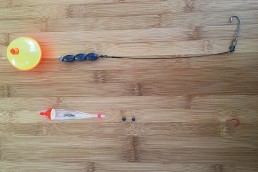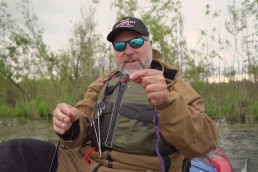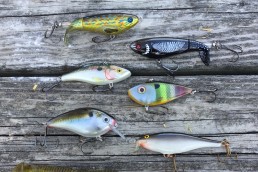Cold Water Bass Fishing from the Bank
SHARE THIS POST
You never can predict when your favorite bass waters will close for open-water fishing, this time of year. Weather forecasting seems to be a gamble at best anymore. A wait-and-see attitude seems to be the least frustrating. Sometime during the month of December, you’ll probably make your last cast before the ice arrives.
Many bank bassers seem to abandon their pursuit of the bass once the water temps drop to near freezing. They then hope for an early spring or maybe continue there bassin’ through the ice.
More cold, less hungry winter bank fishing
The bass have certainly not stopped feeding. They have slowed to a much lesser frequency than a couple of months ago. Being cold-blooded creatures, their body needs less food to sustain itself during these cold-water periods. Bass travel and roam about less, conserving energy for the unknown months ahead under the ice.
The time before ice or freeze over can be an awesome time to tangle with some big fish. My largest bass here in the Midwest—a fish over 8 pounds—came exactly one day before the lake I was fishing froze over for the winter. I have fellow bank bassers that share the same results. All catch fish until that lure or bait bounces across the hard-water surface. Even though those temps appear to be calling an end to the bass season, don’t hang up that rod yet.
Simple setups for the season
Let’s take a look at a few simple approaches to bring an end to the 2018 season. When I’m asked for the most effective presentation this time of year, honestly, I would have to admit that live bait produces some incredible results in the coldest of waters. In the bass world today, thought, it seems like the idea of using live bait—no matter what the season—seems to be less than acceptable. I get it, somewhat. I do like to do my angling with artificial baits for the most part. I certainly will switch to some live-bait approaches if that’s what the bass seem to be responding to.
There’s one, main reason live bait works so well. It’s that the presentation or action of that live bait is much slower. It’s exactly what the bass are reacting to or desiring at this time. Some anglers have trouble slowing artificial baits down enough to interest bass. Furthermore, certain baits are just not designed to work at such a slow cadence. While I will never say never to any kind of bait during any season, as fish will prove you wrong, I do limit my choices to a few that work well for this slow approach.
My two factors I always consider when targeting late-season bass with any type of bait are, one, the descent rate of the bait through the water column and two, to always work down to the active fish. You’ll never know on a given day where these fish might be staging, whether it is shallow, deep, or somewhere in between. If you pursue fish through the ice, whether they are bass or other species, always feed or fish down to active fish. If you think bass, for example, are on the bottom and work your bait down to the depths rather quickly, you quite possibly missed a subsurface bite or mid-depth-range feeding and are running your bait through active feeders to a no-fish zone.
This reason in particular, is why I like to fish live bait with an adjustable float to find active fish this time of year, but let’s not give that too much thought. We’re fishing artificial baits in the cold water.
Packing only what works
As I said, pretty much most of my tackle stays behind during winter. My box will have an assortment of jigs and plastic baits and that’s pretty much it. Different weights, lengths, color and sizes, of course, but all picked for these cold conditions.
The most critical factor, to me, to enticing a bass to strike your bait, is the descent rate of that bait through the water column—the rate at which your baits enter the water until they rest on the bottom. This is where many anglers fall short of having successful days while fishing their favorite waters and blame it on the fact that the water is just too cold during this season.
Are you enjoying this post?
You can be among the first to get the latest info on where to go, what to use and how to use it!
Patience is a virtue
Your biggest asset to catching bass is your patience! Not brand preference, not color, not size. If you don’t have the patience to allow your bait to fall at the rate bass are reacting to, chances are your payoff at the end of your time on the water will be little more than cold hands and feet.
How do you determine how fast a descent rate the bass are keying on? Always start slowly. You can never go wrong with starting slow. You can miss them by going too fast, but a slow start is the key. If the bass are hitting fast and aggressively as the bait lowers through the water column, then you might be able to use a bait with a quicker descent rate. The only benefit to using this quicker descent rate is if you find the bass feeding deep and you don’t want your bait spending time descending through unproductive water. Then, get the bait down a little quicker through the water column. This situation will happen on occasion and through the ice, but, for the most part, the slower descent will put fish on the bait.
Bait of choice
What’s my favorite, go-to bait now? I did mention jigs and plastics. If you follow this column, I wrote an article on bucktail jigs for last month. These jigs hold true for this late season, as well. But, I will focus on my simple plastic approach for the sake of this article.
My plastic supply consists of Senko-type baits and 4- to 7-inch-long, straight-tailed, thin finesse worms. Everything else stays back at the fish room, waiting for the warmer conditions after the ice.
Rigging is very simple for both baits. For the Senko-type baits, I predominantly throw them wacky rigged and weightless. I have, on occasions, had to use a wacky jig—usually due to the distance the bass are from shore. But, the additional weight often gives this perfect-fall-rate bait too quick of a trip through the water column for my liking. Simple, 1/0-2/0 finesse wide-gap hooks are my choice for hook sizes. If a wacky jig is a necessity, use the lightest weight possible to achieve your casts.
For my straight, finesse-style worm, I like the Roboworm. While it might be a little test rigging and casting this worm weightless, it has a descent rate slower than an actual live nightcrawler. Unless you use light line, such as 6- to 8-pound test, you might have to rig on a stand-up-type finesse jighead, but try your best to go weightless. The results are amazing. For this worm, I do rig somewhat of a wacky style, but my hook location is closer to the worm head, some refer to it as “gilly hooking”. On this bait, I also rig with a longer-shank hook such as the number 4 Neko hook from VMC. Hook choice varies, so use your favorites.
Where to hook in
I’m targeting offshore locations that have some deep water close to the shore. Good green weeds near the deep water are often a good choice, but no need to fish in the weeds. The bass are normally on the deep side in more open water.
The cast and retrieve are the most critical part of this system—primarily because you do nothing once your bait hits the water. Don’t twitch, snap, or shake. Do nothing other than maybe give a little line to let the bait freefall. Strikes are often subtle, nothing more than a couple of taps on the line. I watch for the line to move to set the hook, but this you will have to decide on your outing.
Even on some cold days or if a hint of snow is in the air, if the water still has a ripple on the surface, give these late-season approaches a try. Some big bass are waiting. If you keep in mind the descent rate of your baits, a late-season trophy might be an awesome way to wrap up the end of 2018!
MWO
SHARE THIS POST
Did you enjoy this post?
You can be among the first to get the latest info on where to go, what to use and how to use it!
Dan Brozowski
Passion for angling drives Dan Brozowski to the water’s edge virtually any chance he gets. Although passion cannot be measured, weighed, or recorded, it can be shared. He does this through his writing and while on the water. If you have any questions or comments for Dan, you may contact him at: onthebank@att.net.



